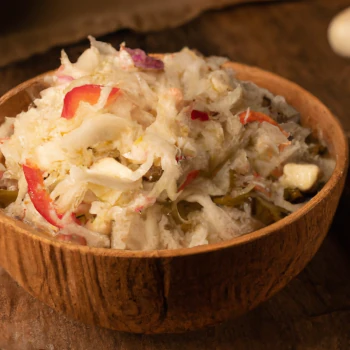Granny's Tangy Sauerkraut Salad

Experience the unique tanginess of Granny's Sauerkraut Salad, a delightful blend of sauerkraut, veggies, and a sweet and sour dressing. This salad is a testament to the power of simple, wholesome ingredients coming together to create something truly special and satisfying.
Granny's Sauerkraut Salad is a symphony of flavors and textures. Crisp vegetables are mixed with tangy sauerkraut and enveloped in a sweet and sour dressing that's seasoned just right. This salad is more than just a side dish; it's a nostalgic journey to Granny's kitchen where every meal is made with a sprinkle of love and a dash of tradition. Whether it's a sunny picnic or a cozy family dinner, Granny's Sauerkraut Salad is sure to bring a smile to your face with every bite.

Ingredients
½ cup chopped green pepper ½ cup chopped celery ½ cup chopped onion ½ cup chopped carrots 1 quart sauerkraut 1 cup sugar ½ cup vinegar ½ cup vegetable oil
Method
- 1. Start by preparing the dressing. Combine the sugar and vinegar in a pot and bring it to a boil. Once boiling, remove from heat and set it aside to cool.
- 2. In a large bowl, combine the chopped green pepper, celery, onion, and carrots. Pour the cooled vinegar and sugar mixture over the vegetables and mix well.
- 3. Drain the sauerkraut thoroughly and add it to the vegetable mixture. Stir well to combine. Add the vegetable oil and mix until it's fully incorporated into the salad.
- 4. Cover the salad and place it in the refrigerator to rest overnight. This allows the flavors to meld together. Stir once more before serving and enjoy!

All About Sauerkraut Salad: A Tangy Delight
Sauerkraut salad, a beloved staple at family gatherings and potlucks, has a fascinating history that is as diverse and varied as the many ways it can be prepared. Its roots can be traced back to various European cuisines, where fermented cabbage is a common ingredient.
Sauerkraut, a form of fermented cabbage, has a rich and storied history that spans continents and millennia. The origins of sauerkraut can be traced back to ancient times, and it has been a staple food in many cultures due to its nutritional benefits and long shelf life.
The process of fermenting cabbage is believed to have originated in China over 2,000 years ago, around the time of the construction of the Great Wall. It was during this time that workers discovered that shredded cabbage, when packed into earthenware pots and left to ferment, transformed into a tangy, flavorful dish that could be stored for extended periods. This was particularly useful during the cold winter months when fresh produce was scarce.
The technique of fermenting cabbage spread westward to Europe, likely carried by nomadic tribes such as the Tartars. In Eastern and Central Europe, particularly in countries like Germany, Poland, and Russia, fermented cabbage took on the form we now recognize as sauerkraut. The cool climates in these regions were ideal for the slow fermentation process required to produce sauerkraut.
In Germany, sauerkraut quickly became a dietary staple. The word "sauerkraut" itself is German, with "sauer" meaning sour and "kraut" meaning cabbage. The dish was valued not only for its flavor but also for its nutritional benefits. The fermentation process enhances the bioavailability of nutrients like vitamin C, and the lactic acid bacteria involved in fermentation are beneficial for gut health.
When German immigrants began settling in America, they brought their culinary traditions with them, including sauerkraut. It was particularly popular among sailors, who found that the vitamin C-rich sauerkraut helped prevent scurvy on long sea voyages.
Today, The beauty of sauerkraut salad lies in its versatility. While the basic recipe includes sauerkraut, vegetables, and a sweet and sour dressing, there are countless regional and personal variations. Some versions might include apples, cranberries, or even bacon. Despite these variations, the essence of sauerkraut salad remains the same - it's a comforting, crowd-pleasing dish that embodies the spirit of communal dining and celebration.
Tips, Tricks, & Serving Suggestions
- Choosing the Right Sauerkraut: While canned sauerkraut can be used for this salad, fresh sauerkraut from the refrigerated section of the grocery store often has a better flavor and texture. But the ideal choice would be a homemade sauerkraut, aged in a fermenting crock.
- Draining the Sauerkraut: Ensure the sauerkraut is thoroughly drained before adding it to the salad to prevent it from becoming too watery.
- Dressing: The base of the dressing is a sweet and sour mixture of vinegar and sugar. Feel free to adjust the ratio of vinegar to sugar to suit your personal taste.
- Add-Ins: Sauerkraut salad is incredibly versatile. Feel free to add in other vegetables in addition to the bell peppers, celery, and onions. For a sweet twist, consider adding diced apples or dried cranberries.
- Chilling Time: Sauerkraut salad tastes best after it has been chilled in the refrigerator overnight. This allows the flavors to meld together. If possible, make your salad the day before you plan to serve it.
- Serving Suggestions: Sauerkraut salad is the perfect side dish for barbecues and picnics, pairing well with grilled meats and sandwiches. It can also be served as part of a cold buffet or as a filling for wraps and pita bread.
- Presentation: Garnish your sauerkraut salad with a sprinkle of fresh herbs like parsley or dill to add a pop of color before serving.
Remember, the best sauerkraut salad is the one that you and your family love, so don't be afraid to experiment and make it your own!